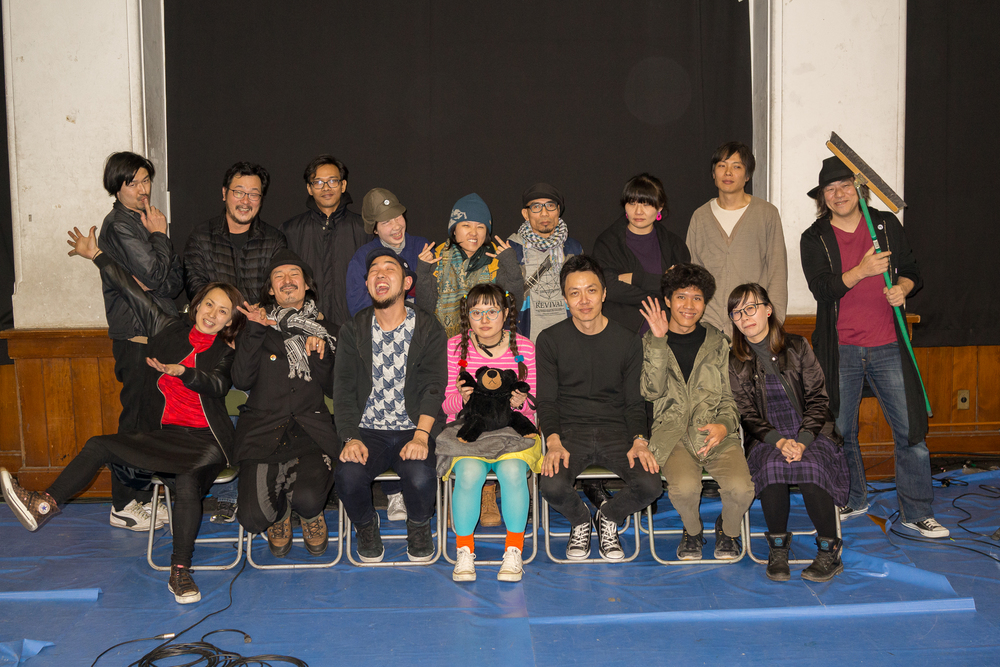Asian Meeting Festival as a form of alternative jazzMorihiro Satow

In the center of what was once an elementary school auditorium is a ring of speakers. Around the speakers sits a portion of the audience. Around the spectators is another ring of instruments and equipment. And around that stands the remainder of the audience. The concentric circles represent a complete departure from the setup of ordinary concerts, where the presence of a stage clearly separates the viewers and the viewed. When the performance begins, the musicians emerge from the dark, illuminated by lamps set up before each of their chairs. This is Day 5 of Asian Meeting Festival 2016 in Kyoto, held at the former Rissei Elementary School.
The first half showcased combinations of three artists at a time in rotation. The musicians explored one another's sound and produced their own, carrying on a conversation through their various "instruments." In the case of a dancer, this instrument was movement. The scene reminded me of different species of animals exchanging calls. The sounds at times clashed, at other times coexisted oblivious to the others, and in part came to reach an understanding.
The variety of instruments--in the sense of objects for producing music--was a curiosity. In its broadest definition, there were synthesizers and sounds generators, where it wasn't immediately clear what the performer was doing or how the sound was produced. And then there were guitars and saxophones, where the performer's movement, the sound source, and the sound produced could easily be linked both visually and audibly. The contrast between these instruments fostered an awareness that the show was not only for the ears but also for the eyes.
The second half consisted of a group session featuring all of the artists. The interplay between sounds, which started with the trio performances, turned ever more complex with a dozen playing at once. It went from quiet search for harmony to chaotic climax and back, over and over again.
Throughout the show, an idea grew in me. My ungrounded impression as an outsider was that this might be some kind of jazz. I say this because, without warning, it reached deep down and brought back the memory of a show I saw in 1982--one that was rather sophisticated for my age then--of the Dutch Instant Composers Pool (ICP) Orchestra at the Kyoto University West Campus gymnasium. I recalled nothing of the fine details of the gig over 30 years ago, and yet I somehow sensed a resemblance. Now that I revisit the recording, the sounds are quite a bit different. First of all, the ICP Orchestra used no electronic instruments. Most importantly, the sound was far more musical. What linked the two concerts in my mind, then, perhaps wasn't the style of the sounds but the festive mood of the performances.
Though it's called a festival, Asian Meeting Festival is in no way one where all members share a common context and create the event in harmony. Instead, it appears to be the type where performers of varying backgrounds build and destroy, spin and unravel, relying on a shared foundation that, according to project directors Yuen Chee Wai and dj sniff, is "a form of experimentalism that bred through more conventional categories of music." Back to the ICP Orchestra, the strongest element that remains in memory is Han Bennink, who strayed from his drum set and struck any and all surfaces in sight, and then even disappeared backstage, where as far as I could tell he was smashing up a stepladder. This was a festival that built and destroyed. And I felt as though, after 30-some years, it was being reborn before my eyes.
Naruyoshi Kikuchi and Yoshio Otani note that improvisation in modern jazz is turning into something of a game. The game they refer to, of course, prevails in the genre of bebop, where musicians compete to perform improvised solos following the rules of chord progression. No structural rule of this kind can be detected in Asian Meeting Festival. But I believe that at a deeper level, there were unspoken rules. What those were, I have no way of comprehending, as I am not a performer.
There's no use trying to define the essence of jazz beyond the era of free jazz, when the modernist movement reached its pinnacle. Jazz history can no longer be expressed with a single line. Today, fragments of multiple branches of jazz music dwell in various genres of other music, and jazz is being reborn in the most unexpected classes and categories. Asian Meeting Festival might be viewed as a form of this rebirth. (Guest performer An Murazato's drum performance left an especially strong impression on me. She never kept a steady beat, but always poured her soul into producing the sharpest possible rhythm in response to the sound of the whole. This, to me, was jazz at its most powerful.)
On the day of the show, at the venue, I bought the CD titled EP (psi, 2011) by one of the project directors dj sniff. He boasts his influences from hip-hop and free jazz. As I listen to the early recordings of free jazz saxophonist Evan Parker being built into new sounds through sampling and turntable scratching, I am convinced that the sound I discovered at Asian Meeting Festival was indeed an a form of alternative jazz.
Morihiro Satow (Professor of Art History/Visual Culture in the Faculty of Design, Kyoto Seika University)
